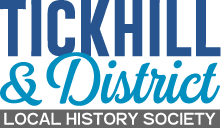

Tickhill’s Register of Electors 1904
Thanks to Sue and Joe Green, TDLHS now has a copy of the list of Tickhill’s Electors in 1904, priced originally at one shilling. As well as giving details of who was eligible to vote in parliamentary, county council and parochial council elections, this Register of Electors provides several insights into life in Tickhill and into national policies at the beginning of the 20th Century. It should be noted that in Tickhill’s case the eligibility to vote in parochial elections meant people could vote for the Urban District Council, created in 1894. The county council elections were for the West Riding County Council whose headquarters in Wakefield were built in 1898. The parliamentary constituency was Doncaster, created in 1885 and, for this area, replaced by the Don Valley constituency in 1948.
How the Register was organised
The Register was divided into several sections. The three main ones were: Ownership Electors (for parliamentary and parochial elections) with 97 names, Occupation Electors other than Lodgers Division 1 (for parliamentary, county and parochial elections) with 257 names, and Occupation Electors Division 3 (for county and parochial elections) with 101 names. The term Occupation Electors did not refer to the electors’ employment but to the fact that they occupied property.
Men who owned property in Tickhill
The Register shows how comparatively few men in Tickhill owned the house in which they lived. Of the 297 Tickhill men eligible to vote in parliamentary elections, about 15% owned their own home; 9 of these men owned more than one house. The low percentage of owners was a similar picture to elsewhere in the country where the great majority of people lived in rented property. Only after the First World War did property ownership begin to increase. Thirty four men who owned houses in Tickhill and another 20 who owned land in Tickhill did not live here; they not only lived in towns such as Doncaster, Rotherham and Chesterfield, but also much further away in London and Kent. These men were registered to vote in parliamentary elections where they lived, but could vote for the local county and parochial (UDC) elections here. Apart from owning buildings, some electors qualified by virtue of land ownership. A, perhaps, surprising feature is that nine ordained ministers who lived in parishes away from Tickhill (in Lancashire, Lincolnshire and Nottinghamshire, for example) owned freehold land or freehold glebe land in Tickhill.
Women’s electoral rights
Whether or not women owned property, and married women’s rights to property ownership had been put on a par with the rights of unmarried women in 1893, they could not, of course, vote in parliamentary elections in 1904. Single women had been able to vote in local elections since 1888 if they met certain criteria, such as being rate payers, and these rights were extended to married women in 1894, although in reality few married women had this right as they could not qualify in respect of the same property as their husbands. It seems extraordinary now that, up to the 20th Century, married women were not in law ‘a person’, their legal existence merged on marriage in that of their husband. In Tickhill in 1904 just 50 women were listed as electors at county and parochial (UDC) elections. Forty-three of these women have been identified through various records. Only 5 of them were married, while 24 were widowed and 14 were unmarried, showing that the great majority of married women in Tickhill did not have a vote, nor did many other women.
Some additional points about the 1904 Register of Electors
- The Register had a category for electors in parochial (UDC) elections only. There was just one name, that of the Earl of Scarbrough, entitled to vote in this type of election by virtue of the freehold land and woodlands he owned in Tickhill.
- Only one man had the right to vote in parliamentary and parochial (UDC) elections by being on the Lodgers List. This was Norman Edward Fullwood, Council Clerk, who had sole use of a furnished bedroom and sitting room at St Mary’s Cottage. Rent was paid to his mother, Marianne Fullwood – not listed as an elector.
- Two men were classed as in occupation but not lodgers who could vote in parliamentary and parochial (UDC) elections. They were both in domestic service, one of them lived at the Friary and worked for Mrs Leather - not listed as an elector.
- One man, Henry Law, listed as the occupant of a shop in Northgate, could vote in county and parochial (UDC) elections but not in parliamentary elections.
How the Register of Electors was compiled
Overseers of Tickhill parish were responsible for preparing the list of electors each year. The list could be revised by a Revising Barrister at court. In 1904 this barrister added three revisions. Two related to Henry Shaw (brickyard owner) who owned freehold land in Balby and Barnby Dun, and one to George Crossland, photographer, who owned freehold shops in Mexbrough. Both were eligible to be parliamentary electors and to vote at Tickhill.